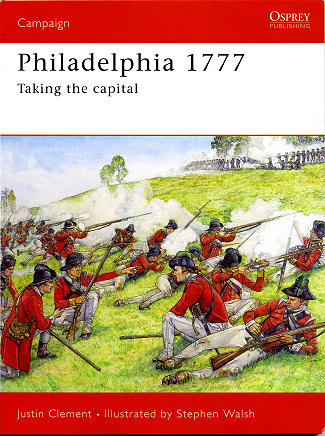 The
American Revolutionary War was a case of an act of putting forth grievances
against what was the home nation of Great Britian, turning into a conflict for
independence. It was something that just grew in importance as time went on. By
1777, the war was in its second year. The British had managed to take New York
and some other important cities, yet the Continental Army had won a few battles,
but mostly had been on the losing end. Fortunately, most of the army had
survived intact and by the spring of 1777 was in western New Jersey, wondering
just what the British would do next.
The
American Revolutionary War was a case of an act of putting forth grievances
against what was the home nation of Great Britian, turning into a conflict for
independence. It was something that just grew in importance as time went on. By
1777, the war was in its second year. The British had managed to take New York
and some other important cities, yet the Continental Army had won a few battles,
but mostly had been on the losing end. Fortunately, most of the army had
survived intact and by the spring of 1777 was in western New Jersey, wondering
just what the British would do next.
For the British, they had hoped to campaign from Canada,
marching down the Hudson River area to cut the Colonies in half and thereby
isolate the various militias and portions of the Continental Army where they
could be destroyed in sections. It was also felt that it would be advantageous
to capture the rebel capital of Philadelphia, feeling that doing so would remove
the will of the rebels to fight. After quickly concluding that campaign, the
forces could then move to the Hudson River valley and join with the forces
fighting in that area.
However, the usual problem with plans in war is that they go
astray as soon as they are undertaken. The Royal Navy embarked the men of Lord
Howe to sail from New York into the Chesapeake and up to Philadelphia where they
would be offloaded. However, the journey was a long one, taking over a month and
causing the loss of horses and men to disease during the long trip packed in
tight quarters.
When they got to the Philadelphia area, Washington had
fortified the areas around the city and on several islands in the Delaware
River. The Pennsylvania Navy had not only blocked the Delaware river to prevent
ship traffic, but was also patrolling the waters to prevent British ships from
moving close to Philadelphia.
The result of all this was that the British had to off-load
down stream and fight their way towards Philadelphia. The Continental Army did a
superb job of not only delaying the British, but in several fierce battles,
whittled away at their troop numbers. The end result of all this was that the
British did eventually capture Philadelphia, but too late in the year to help
the force from Canada who ended up being defeated by the Continental Army.
Taking Philadelphia was a tactical victory for the British but a strategic loss.
The Continental Army was not broken up, the British found that the rebel
government had simply left the city and was still intact, and the cost of
maintaining the hold on the city was such that they left the next year. It was
also a set of battles that brings us Lafayette and the eventual involvement of
France on the side of the rebel forces.
Justin Clement tells the story of the battles with great
clarity, pulling the reader into the prose. The superb illustrations and maps of
Stephen Walsh further enhance the story along with photos of the various sites,
period illustrations and artifacts. The 3-D maps in particular help give a sense
of the flow of the various battles.
It is a great book, especially for the student of the
Revolutionary War and shows that often times victory is fleeting and the best
laid plans oft go astray. A book I know you will enjoy reading.
September 2007
For more on the complete line of Osprey books,
visit www.ospreypublishing.com. In the US, it is
Osprey Direct at 44-02 23rd St, Suite 219, Long Island City, NY 11101., where you can
get a catalogue of available books.
If you would like your product reviewed fairly and quickly by a
site that has nearly 400,000 visitors a month, please contact
me or see other details in the Note to
Contributors.
 The
American Revolutionary War was a case of an act of putting forth grievances
against what was the home nation of Great Britian, turning into a conflict for
independence. It was something that just grew in importance as time went on. By
1777, the war was in its second year. The British had managed to take New York
and some other important cities, yet the Continental Army had won a few battles,
but mostly had been on the losing end. Fortunately, most of the army had
survived intact and by the spring of 1777 was in western New Jersey, wondering
just what the British would do next.
The
American Revolutionary War was a case of an act of putting forth grievances
against what was the home nation of Great Britian, turning into a conflict for
independence. It was something that just grew in importance as time went on. By
1777, the war was in its second year. The British had managed to take New York
and some other important cities, yet the Continental Army had won a few battles,
but mostly had been on the losing end. Fortunately, most of the army had
survived intact and by the spring of 1777 was in western New Jersey, wondering
just what the British would do next.